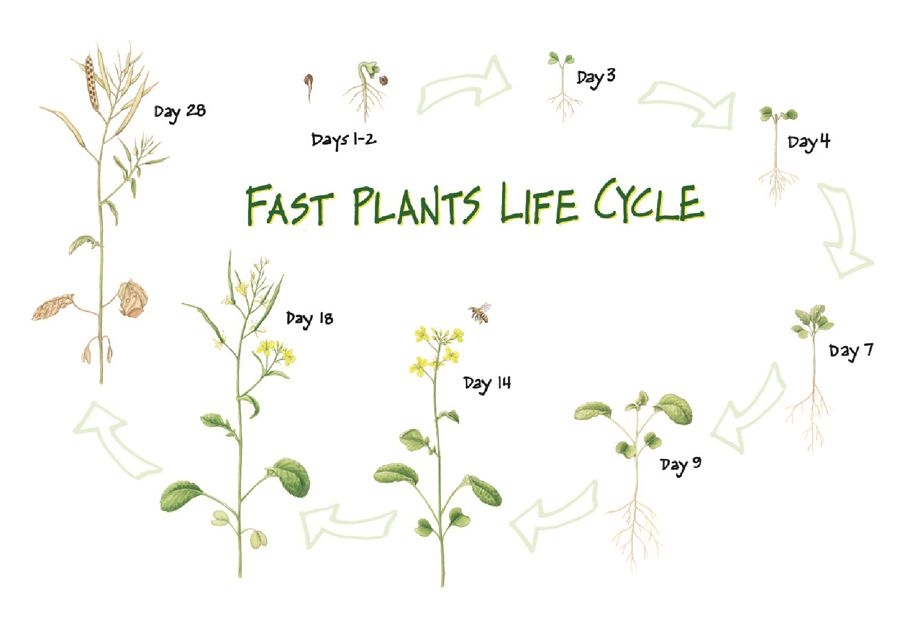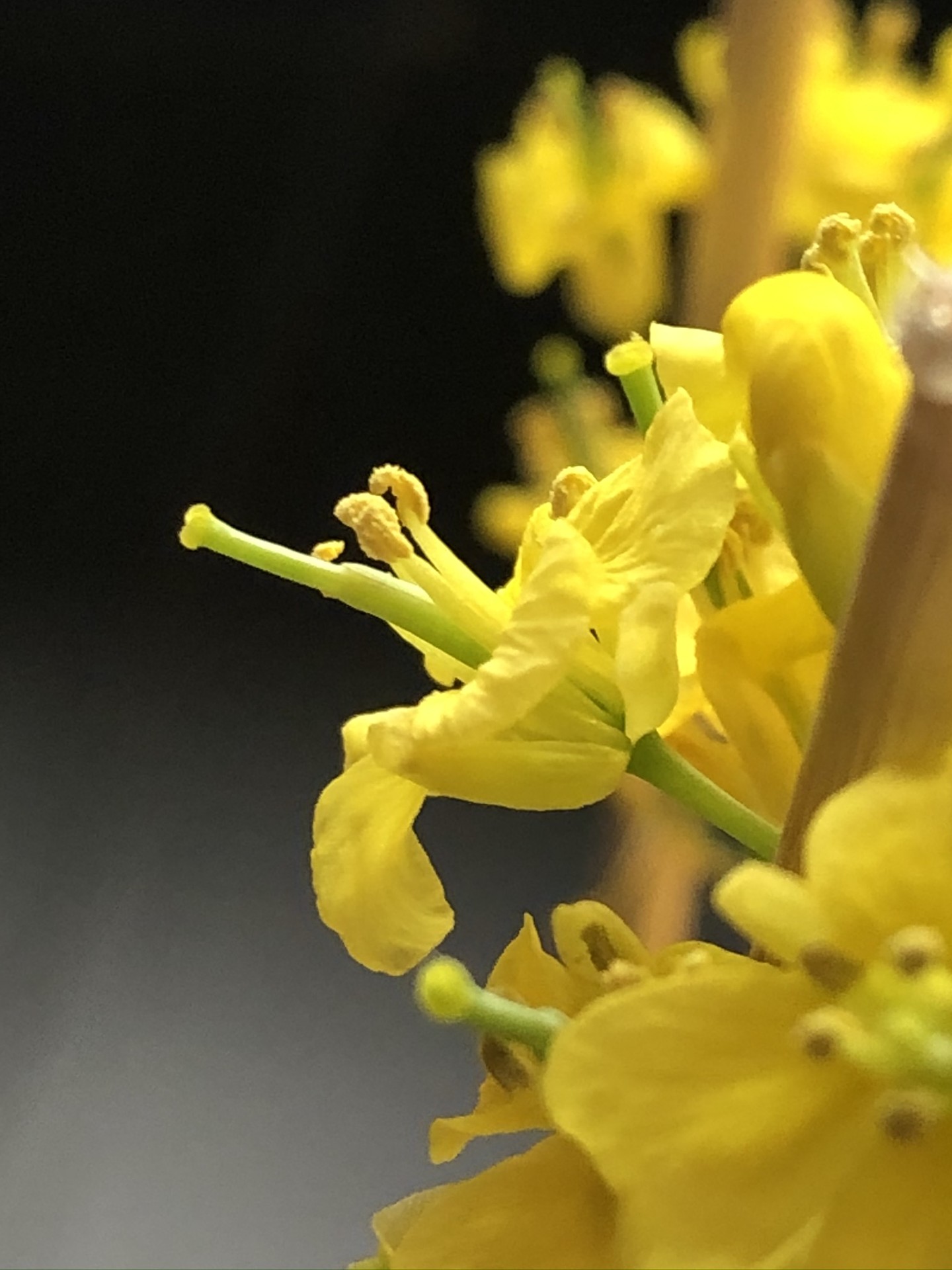Let Wisconsin Fast Plants® Grow on You!
Wisconsin Fast Plants® are so captivating to watch as they grow and develop that even students who are tough to reach become engaged and attached to them. Time after time, I saw students I least expected to be interested in anything science come to my class during a unit with Fast Plants® and head straight to the grow lights to check on their plants. If you think plants are boring, think again. Try teaching with Wisconsin Fast Plants®. I know you’ll be glad you did.

A speedy life cycle
The Fast Plants® life cycle is quick. Just 14 days after planting seeds, students experience firsthand how plants reproduce as their plants develop buds that open into bright yellow flowers. Kindergarten through high school students (and college students too!) smile and learn when they “fly” their bee sticks from plant to plant to pollinate them. They can see the pollen on their bees and watch seeds develop inside the elongating pistils of their plants’ flowers. No reading on life cycles, video, or simulation can come close to the experience of learning by growing these plants.
If your class can’t spare 2 weeks for growing plants, students can observe Fast Plants® seedlings germinated in a petri dish in just 72 hours. Carolina Biological Supply Company has Wisconsin Fast Plants® seeds available in seed disks: petri dish—sized paper disks embedded with seeds for easy planting in soil or germinating in a petri dish. Seed disks are available for the standard variety of Wisconsin Fast Plants® and several of the specially bred genetic inheritance stocks.
Fast Plants® and genetics
Wisconsin Fast Plants® genetic stocks show the inheritance pattern that results when a parent homozygous for a dominant trait (like purple stem) is crossed with a parent homozygous for a recessive trait (non-purple stem, in this example). It’s genetics you can easily observe, even in 72-hour-old seedlings!
One of the great characteristics of Wisconsin Fast Plants® is that they don’t self-pollinate (unlike many flowering plants), so every Fast Plant® had 2 different parents (sexual reproduction without the complication of self-pollination). This means that students can actually calculate and explain the ratio of dominant to recessive traits they observe, much like Gregor Mendel did. It is no surprise that students are far more invested in figuring out what their own 3:1 or 9:3:3:1 ratios mean than studying a textbook or worksheet on Punnett squares.
Fast Plants® for every level
In many school districts, Wisconsin Fast Plants® materials are a part of the science curriculum in elementary, middle, and high school biology and environmental science courses. Elementary Fast Plants® investigations typically integrate strong English language arts elements with mathematics instruction about measurement, units, and data representation and interpretation. Continuing into middle and high school levels with Fast Plants® investigations can foster three-dimensional teaching–weaving together opportunities for learning the practices of science and engineering with crosscutting concepts and disciplinary core ideas.
Don’t worry if you lack a green thumb. Wisconsin Fast Plants® materials have been tested and refined by classroom teachers for nearly 30 years, and the support team at Carolina is just a call away. Plus, the Wisconsin Fast Plants® section at Carolina.com is packed with helpful tips and resources.
Ready to get started? See the following tables for recommended kits and investigations at the elementary, middle, and high school levels.

Recommended kits and investigations for elementary school (K—5)
Wisconsin Fast Plants® Elementary Exploration of Plant Life Cycles Kit
A complete classroom kit for getting started with Wisconsin Fast Plants®. Includes step-by-step instructions for planting, tending, pollinating, and producing seed. Kit includes seeds and planting materials for 8 student groups. A light source is required (sold separately).
Reading Green™: Investigating the Life Cycle and Growth of Flowering Plants Kit
A complete classroom kit for growing Wisconsin Fast Plants® with lessons that integrate English language arts, mathematics, and science. Includes seeds and planting materials for 8 student groups. A light source is required (sold separately).
Recommended kits and investigations for middle school (6—8)
Wisconsin Fast Plants® Growth, Development, and Reproduction Advanced Classroom Kit
A complete classroom kit for getting started with Wisconsin Fast Plants®, written for the middle or high school teacher. Includes step-by-step instructions for planting, tending, pollinating, and producing seed for an offspring generation (optional). A light source is required (sold separately).
Wisconsin Fast Plants® Who’s the Father? Investigating Genetics Monohybrid Kit
This kit includes everything needed for students to use observations and plant breeding to figure out why non-purple stem plants occur infrequently in Fast Plants® offspring generations compared to purple stem plants. All materials and seeds for the parent plants and first generation offspring are included. A light source is required (sold separately).
Recommended kits and investigations for high school (9—12)
Wisconsin Fast Plants® Growth, Development, and Reproduction Advanced Kits
A complete classroom kit for getting started with Wisconsin Fast Plants®, written for the middle- or high school—level teacher. Includes step-by-step instructions for planting, tending, pollinating, and producing seed for an offspring generation (optional). A light source is required (sold separately).
Wisconsin Fast Plants® 72-Hour Monohybrid Genetics Kit
This monohybrid (1 trait) kit has students germinate Wisconsin Fast Plants® seeds without using soil and observe the stem color of 3-day-old seedlings. Can be used successfully with natural window light or a lamp containing a compact fluorescent bulb (24-hour light is not necessary for this activity).
Fast Plant® activities without kits
If you don’t need a kit, many activities can be completed with a planting system, a light, and one of our many varieties of Wisconsin Fast Plants® Seeds. The confetti seed mix is great for looking at the variation that can exist within a species. Standard seeds lend themselves well to studies of environmental effects, such as:
-
Light (light vs. dark conditions)
-
Moisture (allow 1 or 2 plants to dry out or try to germinate seeds without water as evidence that plants need water)
-
Fertilizer (no fertilizer or too much fertilizer vs. the recommended amount)
Along the way students at every level can learn to make observations, collect data and analyze the data in an age-appropriate way.




